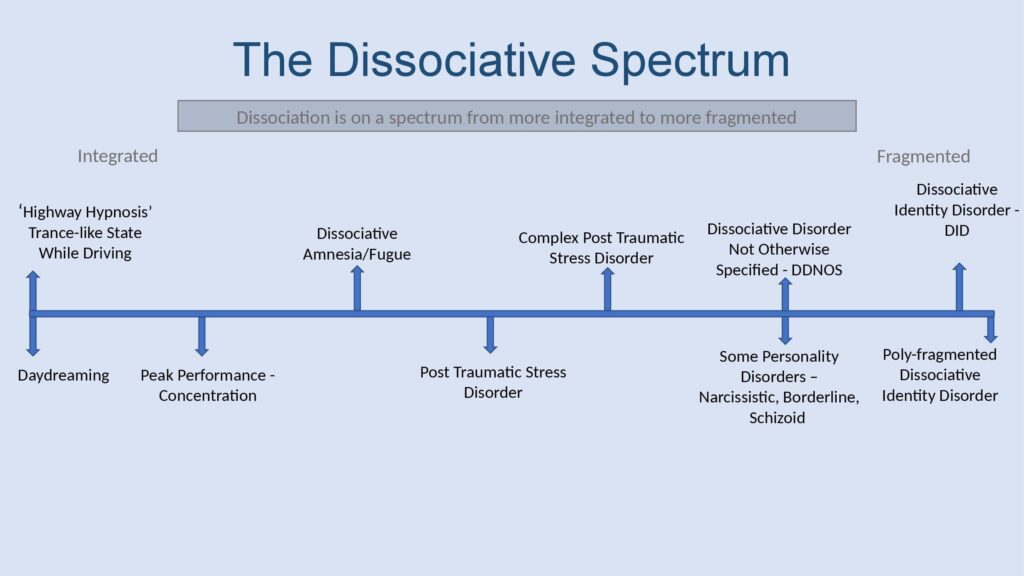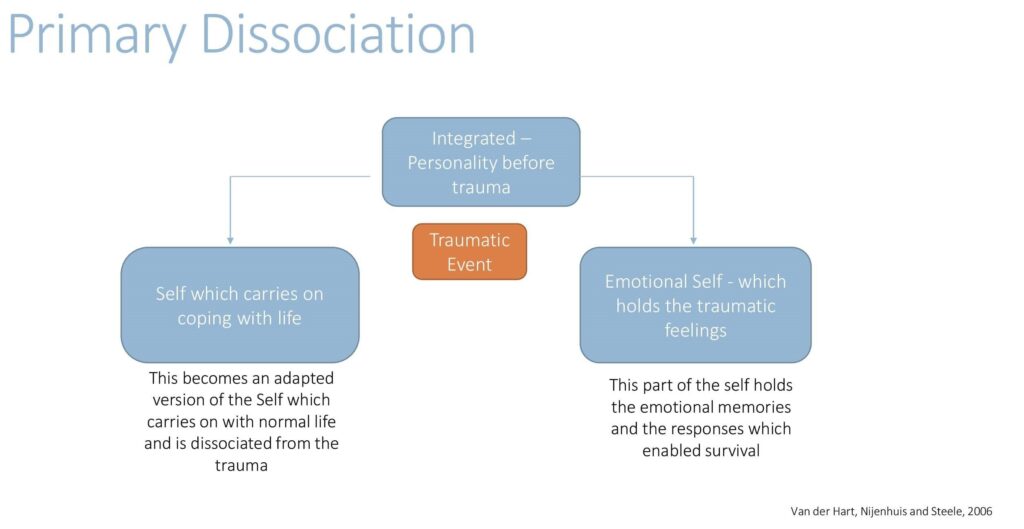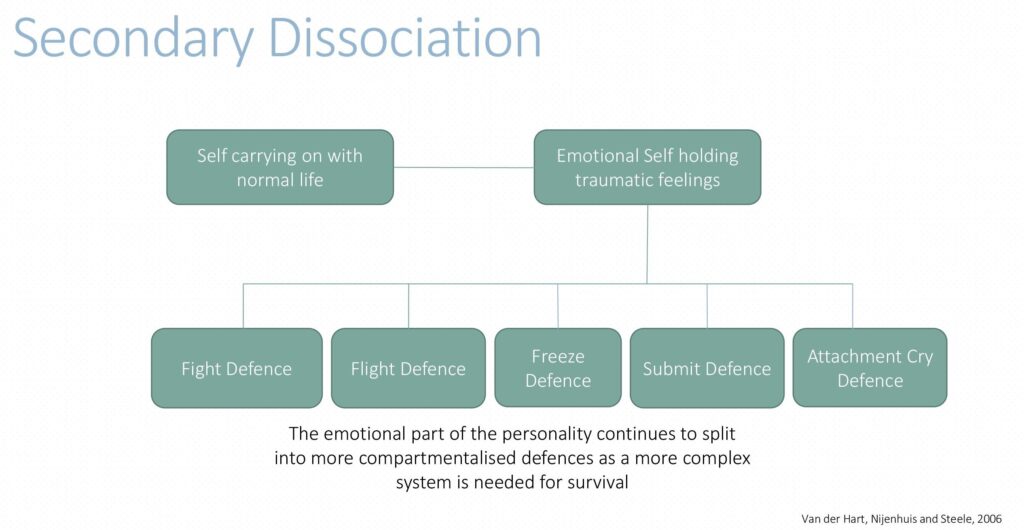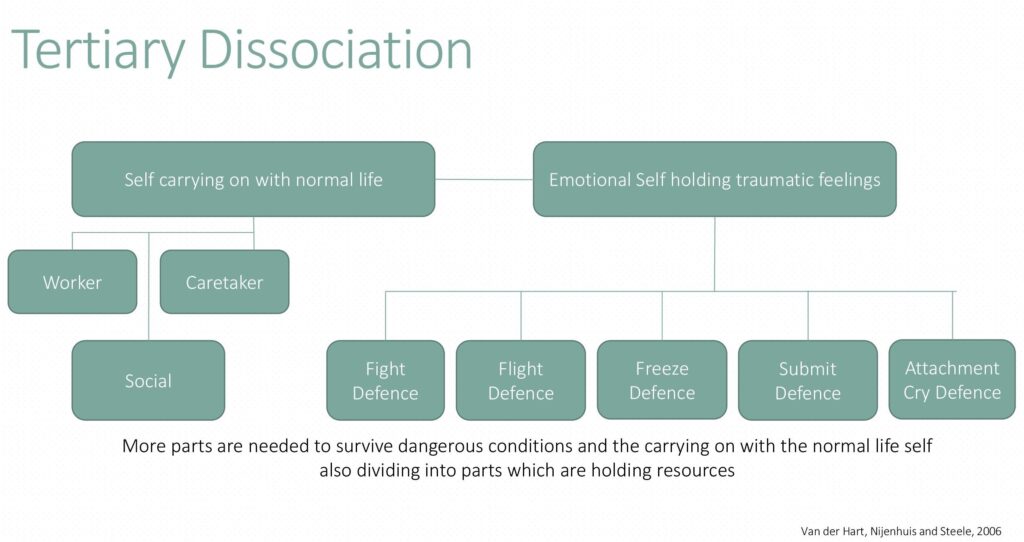The Structural Dissociation Model

Dissociation is on a spectrum ranging from daydreaming to DID – Dissociative Identity Disorder (formerly Multiple Personality Disorder).
Normal dissociation means to go onto automatic pilot when doing an activity (for example, when driving a car and not having to pay a lot of attention to the task at hand and getting to the destination safely) and more complex dissociation means to develop a strategy of managing the environment and emotions with techniques such as repression and detachment. This is a system of defences that are structured to keep the individual as safe as possible from pain, fear and abuse – the Structural Dissociation Model.
The process of dissociation can be likened to a honeycomb where the traumatic memories and feelings are compartmentalised into smaller and more manageable sections with amnesiac walls around them.
Dissociation
"Dissociation refers to a compartmentalisation of experience: elements of an experience are not integrated into a unitary whole but are stored in isolated fragments....Dissociation is a way of organising information."
- van der Hart, van der Kolk and Boon, 1998
Types of Dissociation
Primary Dissociation can occur from a single traumatic incident. A split in the personality helps to manage an incident that feels overwhelming. Traumatic memories are recorded in the right hand brain outside of conscious awareness in the form of images and feelings, the behavioural response used is also recorded. The left hand brain is the CEO and learns, organises and makes meaning from events. It is also the observer of our lives. This part can carry on with normal life consciously unaware of the trauma that has happened.

Secondary Dissociation can occur when a person is subject to prolonged trauma/neglect from which they cannot escape and the emotional part of the personality becomes more fragmented and split. The subparts evolve to reflect the different strategies needed for survival.
Here we can find Complex PTSD, Bipolar, Borderline Personality Disorder and DDNOS (Dissociative Disorder Not Otherwise Specified). It may also be said that Narcissistic Personality Disorder belongs here.

Tertiary Dissociation is when more survival responses are needed and the ‘going on with normal life’ self can also be fragmented into subparts consisting of worker, caretaker and social parts. Here we can find Severe DDNOS and Dissociative Identity Disorder.
Structural Dissociation is an adaptation of the mammalian defence mechanisms, innate within us, to stress. When a child is in a position of extreme stress as they are living in an unsafe environment with an unsafe parental figure, the mammalian defences of Fight, Flight, Freeze, Submit and Attach become less integrated and more compartmentalised.

Biology
When the body if triggered into action by cues in the environment it will go into either hyperarousal (fight or flight) or hypoarousal (freeze or submit). These are what is known as ‘procedurally learned responses’ which means they are automatic responses from the system of defence mechanisms unique to each individual.
A person’s defence mechanisms are tailored to their life experiences and to what has previously worked best for them in situations where they have felt under threat.
Each part of the personality contributes a defensive strategy, for example, Fight is a hypervigilant soldier always on the lookout for danger and can be holding the ‘suicide card’ if the drugs/alcohol/other addiction does not work. Flight rescues us from pain by using addictive behaviours to get relief from painful feelings by ‘turning off’ the body.
Also see The Brain and Trauma
Hyperarousal
"If an individual is born into a malevolent world it is crucial for survival to maintain a state of vigilance and suspiciousness that enables him to readily detect danger."
Tiecher et al, 2002
Recognising Parts of the Self
Personality disorders and DDNOS can show themselves as ‘mood states’ or ‘ego states’ or body memories which are part of the system of defences. It is a structure primed for danger and will be triggered by cues in the environment. Please see Triggers and Triggering.
The clues to our being triggered can be found in our bodily responses. Triggered reactions are sudden and intense and hard to change once they have taken hold.
Structural dissociation can be likened to a honeycomb structure where different survival strategies and traumatic feelings and memories are stored in fragments in different compartments. They may not have conscious awareness of each other until some healing has taken place.
This means that the personality has a ‘going on with normal life self’ (the self you know as you) and these other parts which have been stored in the subconscious. These other parts will be triggered when needed for defence when they are then co-conscious with the ‘going on with normal life’ self. This is known as ‘blending’. These parts of the self are generally ‘frozen in time’ at the time they were created and they tend to respond to situations as though the old trauma, which was happening when they were created, is happening now. These may feel childlike or teenlike.
Recognising parts in the body
Fight can show itself as tension in the neck, arms and shoulders.
Flight can show itself as movement impulses in the legs and feet and/or sitting on the edge of a chair.
Freeze can show itself if the body becomes immobilised, agitated or the eyes widen.
Submit shows itself in postural collapse, averted gaze and the head hanging down.
The Attachment cry shows itself in the eyes, hands, and head being orientated towards the source of help.
Recognising parts in emotions and thoughts
Fight is a protector and can be mistrustful, devaluing, self-harming and suicidal.
Flight is a distancer and has addictive behaviours and/or the desire to run away. Also may feel trapped and unsafe.
Freeze is terrified and can have panic attacks. Feels fear and has beliefs related to danger and annihilation.
Submit feels ashamed, hopeless and full of self-hatred. It has a fear of displeasing.
Attach feels needy, desperate and is childlike and dependent. It wants to feel close and fears abandonment. It yearns for someone to come.
Neurobiological Roots of Dissociation
“Human infants begin life with an immature brain and body, lacking the capacity to regulate their biobehavioral states without the external mediation of their caretakers. Ideally, during this stage of development, attuned parents interactively regulate babies’ dysregulated states, helping them expand their capacity to sustain positive moods, recover more quickly from dysregulation, and communicate via social engagement their physical and interpersonal needs (Putnam, 1997; Shore, 2004; Ogden et al, 2006). Our capacity for affect tolerance and the achievement of an integrated sense of self later in life is dependent upon these self-regulatory abilities acquired during early development, both the ability for interactive regulation (to be soothed by others) and auto-regulation (soothing ourselves).
In addition, because dysregulated autonomic arousal inhibits activity in the prefrontal cortex (LeDoux, 2002), even the child’s ability to learn, problem-solve, and verbally communicate is dependent upon self-regulatory capacity and therefore on the quality of early attachment. Without interactive regulation from securely attached parents, small children must depend on their ability to alter consciousness when soothing is needed and on the body’s innate “fault lines” for compartmentalizing overwhelming experiences (Van der Hart, Nijenhuis & Steele, 2004; 2006).”
This is an extract from the document below by Dr. Janina Fisher which explains the neurobiological background to dissociative disorders and how they can be treated.
The Guest House
This being human is a guest house.
Every morning a new arrival.
A joy, a depression, a meanness,
some momentary awareness comes
as an unexpected visitor.
Welcome and entertain them all!
Even if they’re a crowd of sorrows,
who violently sweep your house
empty of its furniture,
still,
treat each guest honorably.
He may be clearing you out
for some new delight.
The dark thought, the shame, the malice,
meet them at the door laughing,
and invite them in.
Be grateful for whoever comes,
because each has been sent
as a guide from beyond.
Rumi



